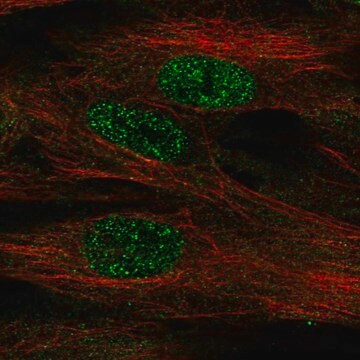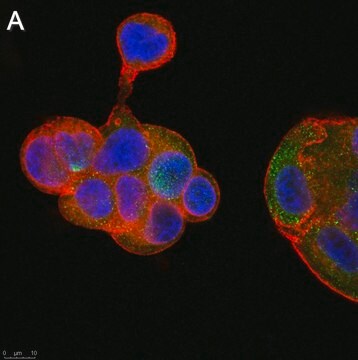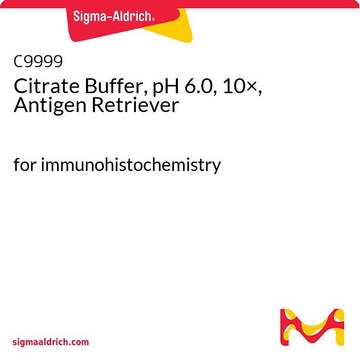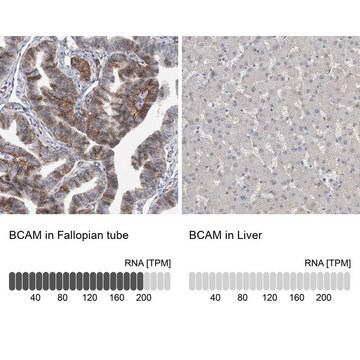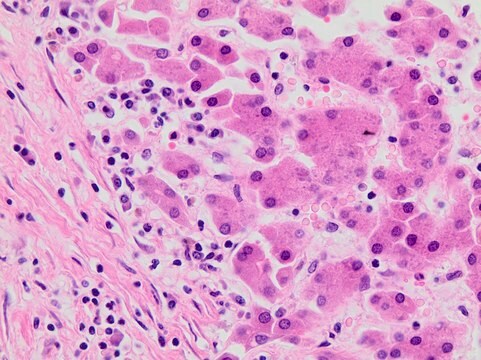MABF2129
Anti-Chlamydial MOMP Antibody, clone B-D3
clone B-D3, from mouse
Synonym(e):
Chlamydia major outer membrane protein
About This Item
Empfohlene Produkte
Biologische Quelle
mouse
Antikörperform
purified immunoglobulin
Antikörper-Produkttyp
primary antibodies
Klon
B-D3, monoclonal
Speziesreaktivität
Chlamydia, bacteria
Verpackung
antibody small pack of 25 μg
Methode(n)
dot blot: suitable
immunocytochemistry: suitable
immunofluorescence: suitable
immunoprecipitation (IP): suitable
neutralization: suitable
Isotyp
IgG2bκ
Posttranslationale Modifikation Target
unmodified
Allgemeine Beschreibung
Spezifität
Immunogen
Anwendung
Entzündung & Immunologie
Immunoprecipitation Analysis: A representative lot immunoprecipitated Chlamydial MOMP in Immunoprecipitation applications (Zhang, Y.X., et. al. (1987). J Immunol. 138(2):575-81).
Immunocytochemistry Analysis: A 1:800 dilution from a representative lot detected Chlamydial MOMP in McCoy cells infected with LGV serovar L2 inclusions (Courtesy of Chunfu Yang, Ph.D. and Harlan D. Caldwell, Ph.D., National Institutes of Health, Bethesda, MD USA).
Immunofluorescence Analysis: A representative lot detected Chlamydial MOMP in Immunofluorescence applications (Zhang, Y.X., et. al. (1987). J Immunol. 138(2):575-81).
Dot Blot Analysis: A representative lot detected Chlamydial MOMP in Dot Blot applications (Zhang, Y.X., et. al. (1987). J Immunol. 138(2):575-81).
Qualität
Isotyping Analysis: The identity of this monoclonal antibody is confirmed by isotyping test to be mouse IgG2b.
Zielbeschreibung
Physikalische Form
Lagerung und Haltbarkeit
Sonstige Hinweise
Haftungsausschluss
Sie haben nicht das passende Produkt gefunden?
Probieren Sie unser Produkt-Auswahlhilfe. aus.
Analysenzertifikate (COA)
Suchen Sie nach Analysenzertifikate (COA), indem Sie die Lot-/Chargennummer des Produkts eingeben. Lot- und Chargennummern sind auf dem Produktetikett hinter den Wörtern ‘Lot’ oder ‘Batch’ (Lot oder Charge) zu finden.
Besitzen Sie dieses Produkt bereits?
In der Dokumentenbibliothek finden Sie die Dokumentation zu den Produkten, die Sie kürzlich erworben haben.
Unser Team von Wissenschaftlern verfügt über Erfahrung in allen Forschungsbereichen einschließlich Life Science, Materialwissenschaften, chemischer Synthese, Chromatographie, Analytik und vielen mehr..
Setzen Sie sich mit dem technischen Dienst in Verbindung.


